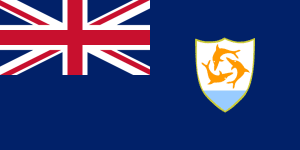
| Colors | HEX Code | RGB | CMYK |
|---|---|---|---|
| Blue | #012169 | 1, 33, 105 | 99, 69, 0, 59 |
| Red | #C8102E | 200, 16, 46 | 0, 92, 77, 22 |
| Orange | #FF9900 | 255, 153, 0 | 0, 40, 100, 0 |
| White | #FFFFFF | 255, 255, 255 | 0, 0, 0, 0 |
| Turquoise | #99CCFF | 153, 204, 255 | 40, 20, 0, 0 |
The Anguilla flag is made of a wide blue space with the British Traditional Union Jack on the left top and a shield with three orange dolphins on the down right side. The shield is divided into two stripes of white and blue. The white stripe on the shield is wider than the blue, with three orange dolphins in the middle, swimming in circular shape.
Anguilla Flag Meaning
The Anguilla flag symbolizes the close relationship between Anguilla and Great Britain. The turquoise color stands for the sea, youth, faith, and hope. The white color stands for peace and tranquillity, and the three orange dolphins are a symbol of endurance, unity, and strength. They also come in a circle implying continuity.
Anguilla flag History
Until 1967, the Anguilla flag was the traditional Union Jack of Great Britain, since it was an overseas British territory. After a revolution against neglect in 1967, a new flag was introduced, with two mermaids and a shell in between. The flag did not receive acceptance and was soon replaced by the three-dolphin flag, which has blue and white stripes with three interlocking orange dolphins in the middle. In 1969, Anguilla was under British rule again, and then it became a separate English colony in 1980. Feeling the need to have an official flag of its own, Mr. Brian Canty, a former governor of Anguilla, drew sketches and sent them to London for approval. The new flag was first hoisted on May 30, 1990. It represents the relationship of the country with the United Kingdom, together with the dolphins that represent Anguilla.